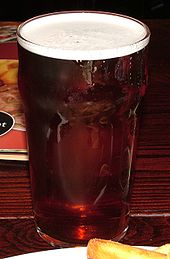This is an old revision of this page, as edited by Yandman (talk | contribs) at 09:30, 20 March 2014 (Reverted edits by 78.116.150.102 (talk) to last version by Northamerica1000). The present address (URL) is a permanent link to this revision, which may differ significantly from the current revision.
Revision as of 09:30, 20 March 2014 by Yandman (talk | contribs) (Reverted edits by 78.116.150.102 (talk) to last version by Northamerica1000)(diff) ← Previous revision | Latest revision (diff) | Newer revision → (diff)
Bitter is an English term for pale ale. Bitters vary in colour from gold to dark amber and in strength from 3% to 7% alcohol by volume.
Brief history
Pale ale was a term used for beers made from malt dried with coke. Coke had been first used for roasting malt in 1642, and in around 1703 the term pale ale was first used. By 1784, advertisements were appearing in the Calcutta Gazette for "light and excellent" pale ale. By 1830, the expressions bitter and pale ale were synonymous in England where breweries would tend to designate beers as pale ale, though customers in the pub would commonly refer to the same beers as bitter. It is thought that customers used the term bitter to differentiate these pale ales from other less noticeably hopped beers such as porter and mild. By the mid to late 20th century, while brewers were still labelling bottled beers as pale ale, they had begun identifying cask beers as bitter, except those from Burton on Trent, which tend to be referred to as pale ales regardless of the method of dispatch.
Style
Bitter belongs to the pale ale style and can have a great variety of strength, flavour and appearance from dark amber to a golden summer ale. It can go under 3% abv - known as Boys Bitter - and as high as 7% with premium or strong bitters. The colour may be controlled by the addition of caramel colour.
Sub-types of bitter

British brewers have several loose names for variations in beer strength, such as best bitter, special bitter, extra special bitter, and premium bitter. There is no agreed and defined difference between an ordinary and a best bitter other than one particular brewery's best bitter will usually be stronger than its ordinary. Two groups of drinkers may mark differently the point at which a best bitter then becomes a premium bitter. Hop levels will vary within each sub group, though there is a tendency for the hops in the session bitter group to be more noticeable.
Drinkers tend to loosely group the beers into:
Light ale
Light ale is a low abv bitter, often bottled.
Session or ordinary bitter
Strength up to 4.1% abv. The majority of British beers with the name India Pale Ale will be found in this group, such as Greene King IPA, Deuchars IPA, Flowers IPA, Wadworth Henrys Original IPA, etc. IPAs with gravities below 1040º have been brewed in Britain since at least the 1920s. This is the most common strength of bitter sold in British pubs. It accounted for 16.9% of pub sales in 2003.
Best or special bitter
Strength between 4.2% and 4.7% abv. In the United Kingdom bitter above 4.2% abv accounted for just 2.9% of pub sales in 2003. The disappearance of weaker bitters from some brewers' rosters means "best" bitter is actually the weakest in the range.
Premium or strong bitter
Strength of 4.8% abv and over. Also known as Extra Special Bitter, or in Canada and the USA, ESB. (ESB is a brand name owned by Fuller's Brewery in the UK)
Golden ale
Golden or summer ale has an appearance and profile similar to that of a pale lager. Hop Back Brewery brewed one of the first, called Summer Lightning, in 1989.
See also
References
- Ron Pattinson, Beer, ale and malt liquor: old British beer terminology (2004) http://www.xs4all.nl/~patto1ro/beerale.htm
- "Caramel color: the science and art". DDW Global. 2001. Retrieved 25 August 2010.
- http://www.beerhunter.com/styles/light_ale.html The Beer Hunter, Light Ale
- "Brewing records". London Metropolitan Archives: Whitbread and Barclay Perkins.
{{cite journal}}: Cite journal requires|journal=(help) - ^ "Statistical Handbook". British Beer and Pub Association. 2003: 21. ISSN 1475-3545.
{{cite journal}}: Cite journal requires|journal=(help) - "Hop Back Summer Lightning " Beer Culture with Des de Moor". desdemoor.co.uk. Retrieved 2010-06-05.